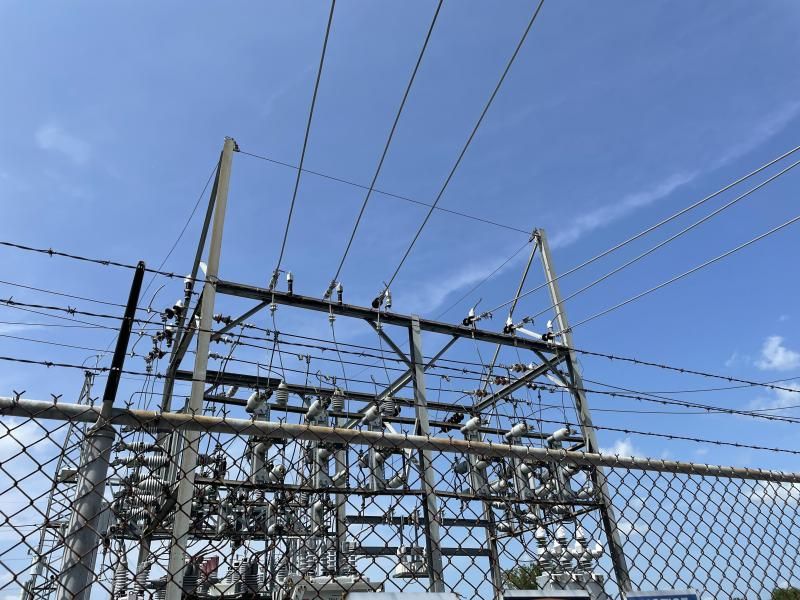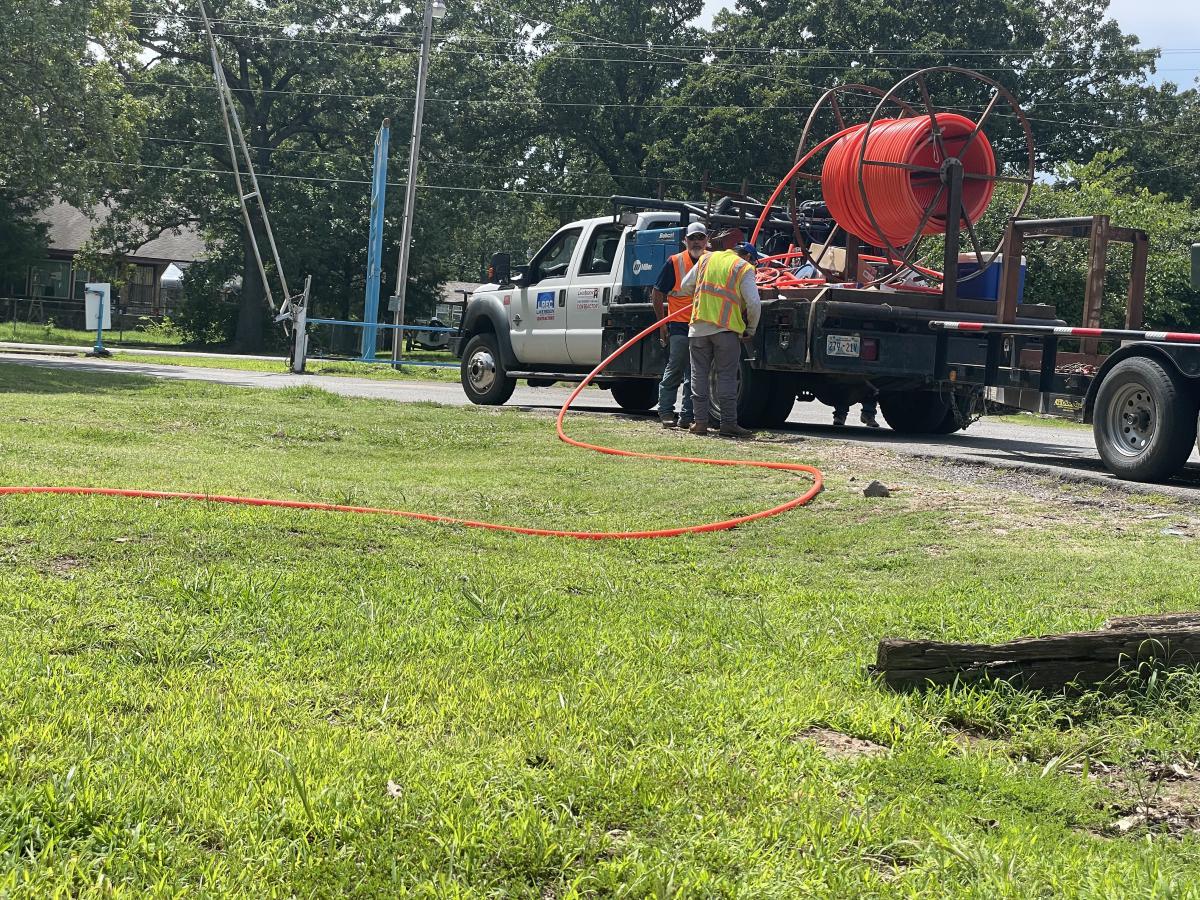
A electric power station near Hulbert, Oklahoma,. Lake Region Electric Cooperative built the area's electric infrastructure when it was formed in 1949. (SETH BODINE / HARVEST PUBLIC MEDIA)
Rural areas are often the last to receive broadband. The lack of broadband is similar to another issue that rural communities faced decades ago — rural electrification.
About 22% of Americans who live in rural areas that lack broadband, compared to 1.5% of those in cities, according to the Federal Communications Commission.
“In rural areas, you can have less than 10 customers for every mile of fiber optics that you have,” says Hamid Vahdatipour, CEO of Lake Region Electric Cooperative. “In town, that number could go as high as 50 or 70 customers per mile, so it is difficult to provide this kind of service for rural America.”

Vahdatipour says rural broadband faces the same basic challenge as electricity: for-profit companies don’t want to invest.
The federal government fixed that issue by setting up cooperatives to help rural residents pay to install poles and lines. Now the same cooperatives that set up electricity want to add broadband to their list of services. But while the challenges are similar, bringing broadband to the countryside is more complicated.
Library hot spots
Teresa Labbé knows how important internet access is for the residents of Okemah, Oklahoma. As the director of the town’s public library, she says there was a consistent 15-20 person line to check out one of six T-Mobile hot spots provided by Oklahoma State University in 2018. The demand was so great, she says, that they eventually received grant funding from other sources like the nonprofit TechSoup to get 25 hot spots.
“It was a constant battle to get people off that waiting list,” Labbé says. “And we don’t have the problem anymore because we have so many.”
In the town of about 3,000 people, Labbé says the internet is for more than just streaming Netflix. It’s how to apply for jobs or access information about Social Security or healthcare. But she says the hot spots only work up to a certain point, depending on how close they are to a cellular tower.
“It's always disappointing to people that come in, check out a hot spot and aren't able to get a signal where they're at,” Labbé says.
Working by lantern
Thomas Edison created the lightbulb in 1879, but rural areas weren’t entirely electrified until the 1960s, says Hal Wallace, the curator of the electricity collections at the Smithsonian's National Museum of American History.
For the most part, cities were the first to receive power grids, but Wallace notes that a few wealthy farmers built independent power plants to light their homes and farms.
“If you're a poor sharecropper, down in Mississippi, you're not going to be able to afford that kind of thing,” Wallace says.
“Part of it is a very practical worry about securing the nation's food supply,” Wallace says. “Because young people are abandoning the farms, they're heading for the cities for factory jobs and for the nightlife.”
A 1940 documentary commissioned by the Rural Electrification Administration shows farmers working by the light of a lantern. Families pump water and wash clothes by hand. In one scene, a farmer tries to sell milk, but the carton is handed back -- the milk is spoiled.
In 1935, Franklin D. Roosevelt created the Rural Electrification Administration. Congress later endorsed it by passing the Rural Electrification Act in 1936. It gave low-interest loans to communities that formed electric cooperatives. The co-ops would build the poles and lines, and residents would pay it off over 30 years through their electric bills.

Danny Brown was 12 years old and remembers what it was like to receive electricity for the first time in his family’s home in Jumbo, Oklahoma around 1953. His mother received a handbook from Choctaw Electric Cooperative, and Brown says she wired the house herself.
The biggest deal, he says, was getting a refrigerator.
“You didn't have the hassle of trying to keep your butter from melting and your milk fresh,” Brown says.
By the 1960s, nearly 98% of rural areas have electricity, Wallace says.
Cooperatives providing broadband
About 200 cooperatives have expanded into providing broadband services today, according to the National Rural Electric Cooperatives Association.
Lake Region Electric Cooperative, founded in 1949, surveyed members and found that they overwhelmingly said the internet played an important role in their lives. Following this, the co-op began laying fiber optic cable in and around Hulbert, Oklahoma, about five years ago.
The high-speed internet service has made a difference for members like James Billinger, who lives outside of Wagoner, Oklahoma. Billinger says he has been getting internet from his cell phone after cancelling satellite internet because it was too expensive.
“It was a bit rough, especially going to school. I had to rely on … using their internet all the time,” Billinger said.
Billinger said he uses the internet to stream Netflix with his dad. He’s also deaf and uses video chatting as a tool for communication.
“I know sign language. So I have to have it for video chatting,” he says. “And satellite just wasn't ideal for that. Fiber is fantastic.”
A different challenge
One of the reasons bringing broadband to rural areas is more complicated than electricity is that there are already providers. But for residents like Virginia Savage, who lives in Chickasha, Oklahoma, her phone hot spot isn’t speedy enough. She’s retired and wants to train as a telehealth professional. When she tried online training, it didn’t work out well.
“The images were real blurry, like looking through one of those glass shower doors. It was just not very good,” Savage says.
Co-ops are interested in providing broadband service, but the cost might be too high even without the need to make a profit. Cooperatives share the cost of building broadband, just like they did when they built electricity. Chris Meyers, general manager of the Oklahoma Association of Rural Electric Cooperatives, says the bills might be too high for smaller co-ops.
“That cost might be $500 a month. Well, I don't know that people can afford that,” Meyers says. “And that's just a number, but just to break even, the cost would be so high that it'd be a problem.”
From 2007 through 2017, the federal government has spent $47 billion on subsidies to expand broadband infrastructure in rural areas, according to a report by the Government Accountability Office.
Tom Wheeler, the former chair of the FCC, says it didn’t work — there are still huge swaths of rural America that don’t have access to broadband.
The 2017 FCC analysis estimates it would take about $80 billion to bring broadband to every home.
Wheeler is hopeful that President Joe Biden’s infrastructure plan and CARES Act money might fulfill the budgetary need. But ultimately, he says there needs to be an approach similar to building roads.
“Build it once and pay for it and go home, instead of this trickling out of money to companies that were basically telephone companies in the hope that they would expand and build broadband,” Wheeler says.













